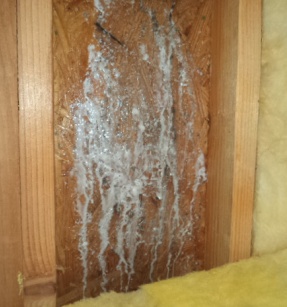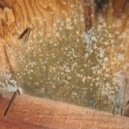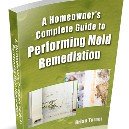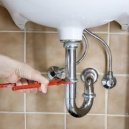Find a pre-screened local mold removal specialist Free Estimate
Find a Mold Specialist Now
Click or Call, Toll-Free 24/7
Attic Mold Treatment
There are really two components to attic mold treatment: removing the mold and repairing whatever defects led to the development of mold in the first place. We’ll tell you how mold is removed from an attic and about common defects or problems, like inadequate insulation and poor ventilation, which often lead to mold growth in attics. We’ll also tell you where you can get more information and how to find professional help if you need it.
Attic Mold Removal
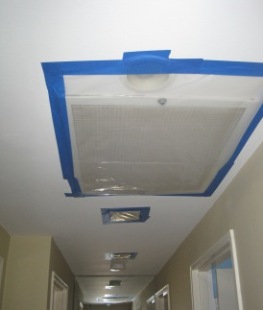 Hi-hats and vents sealed with plastic
Hi-hats and vents sealed with plasticIt’s important to use proper protective gear when removing attic mold, including a full-face N-95 respirator or face mask, protective clothing such as a tyvek suit, work gloves, and eye protection goggles. The attic should also be sealed off from the rest of the home (see picture) and the attic placed under negative pressure. This should be done so that if any mold spores get into the air they are contained in the attic air and not permitted to travel to other unaffected parts of the home. It’s also important to seal any moldy materials in heavy, 6-mil plastic bags, and then the bags should wiped free of dust and debris before carrying them out through the house for disposal. This will prevent the accidental spreading of any mold to previously unaffected areas of the home.
Attic mold treatment begins with removing mold by vacuuming using a HEPA-rated vacuum. This will help to lessen the amount of mold and mold spores that are present. Next, apply a mold killing/cleaning product (we recommend Concrobium Mold Control). Any structural materials that are rotten or show signs of a loss of structural integrity should be replaced. After thoroughly removing the mold, structural components can be painted with a mold-resistant paint, which will help prevent future mold growth. (If you use Concrobium Mold Control, it creates its own mold-resistant barrier and no other type of sealant will be necessary.)
Because wood is somewhat porous, it’s not always possible to remove all traces of mold from wooden surfaces. If mold cannot be completely removed, the wood should be removed and replaced. If it cannot be removed and replaced, a technique called encapsulation is often used. The wood is coated with a special solution that seals in the remaining mold, preventing it from spreading. (We recommend calling in a professional if you have surfaces that require encapsulation, since it’s critical that the job be done correctly in order for it to work.)
There are other materials from which mold cannot be thoroughly removed, such as insulation. If attic mold infestation is severe, all attic insulation should be removed and replaced to reduce the chances of mold redeveloping.
Repairing Defects During Attic Mold Treatment
Attic mold is the result of some type of construction defect. There is no point in attempting to get rid of attic mold unless you first fix whatever problems led to the growth of the mold in the first place. Defects that commonly lead to the growth of mold in an attic include roof or chimney leaks, inadequate insulation, or improper ventilation, which can cause condensation problems. Mold is like every other living organism, it needs a water supply to survive. Condensation will provide that needed water in an otherwise dry attic environment.
Most homeowners are aware that roof leaks can lead to the development of mold in attics and on ceiling drywall, but not all understand how rapidly attic mold problems can escalate. Most strains of mold grow and spread rapidly and mold that begins in the attic can easily spread throughout a home. Mold damages wood and other porous materials and can end up causing structural damage to a home if not addressed in a timely fashion.
In addition, exposure to many types of household mold has been linked to serious health problems, including respiratory disorders, asthma attacks, allergic reactions, headaches and migraines, sore throats, chronic sinus infections and fatigue. The groups of individuals most susceptible to mold include young children, pregnant women, senior citizens, or anyone suffering from a compromised immune system, such as people with AIDS or patients undergoing chemotherapy treatments. The Centers for Disease Control and Prevention (CDC) recommends seeing your primary care physician if you suspect that any of these symptoms are a result of you having been exposed to mold; your doctor can then refer you to a specialist, such as a pulmonologist or allergist, if needed.
Many homeowners are not aware that inadequate insulation and poor ventilation also contribute to mold growth. A well-designed attic is built to help insulate the home. The attic should remain cool in winter while heat is kept downstairs. If there is not enough insulation, though, or if the insulation is not installed properly, the attic may grow warm. Mold grows best in warm areas. Attics are also not meant to be airtight, they need to “breathe”. They should have adequate ventilation so that warm, moist air does not become trapped inside. Homeowners are often unaware of problems with insulation or ventilation until they discover mold growing in an attic. You can follow this link to learn more about how to prevent mold from returning to your attic.
Check out this video to learn more about how problems with insulation and poor ventilation lead to mold growth.
For Help With Attic Mold Treatment
For help dealing with attic mold, we recommend scheduling a free in-home consultation with a qualified mold remediation specialist. An experienced professional will visit your home, inspect your attic and other areas for mold, and advise you about the best way to remove the mold and how to prevent mold from returning again after it is removed. Most mold remediation specialists offer free initial consultations so there’s no obligation and you have nothing to lose. Even if you plan to do the work yourself, you can benefit from some expert advice. To find qualified mold remediation specialists in your area, just follow the link.
Return From Attic Mold Treatment To Home Page
Ref:
CDC: Type of Doctor to See
Free Home Inspection By A Mold Removal Specialist
Search This Website
Recent Articles
-
See Our 5 Recommended Mold Removal Companies in Covington, KY
Apr 16, 25 12:59 PM
-
See Our 5 Recommended Mold Removal Companies in Wheaton, IL
Jun 20, 24 10:33 AM
-
See Our 5 Recommended Mold Removal Companies in Aberdeen, SD
Oct 08, 21 04:05 PM
